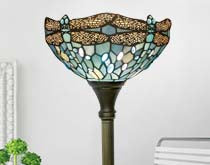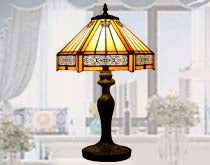How to Repair a Tiffany-Style Glass Lampshade
When a Tiffany lamp shade is inadvertently damaged, many people's first reaction might be to consider if they can repair it themselves to minimize the repair costs.
However, a successful repair requires not only skill but also specific tools and materials. Preparing replacement glass pieces is essential, and other tools like a soldering iron, pliers, glass cutter, and sandpaper are also needed.
For those with a knack for DIY, self-repair is entirely feasible. To assist you in the process, we've put together a comprehensive step-by-step guide on how to restore the original brilliance of your Tiffany-style lampshade.

What is a Tiffany Stained Glass Lampshade?
The Tiffany-style lampshade, stemming from the decorative art style of the late 19th to early 20th century, was designed and popularized by Louis Comfort Tiffany. Its allure lies in the unique colored glass design.
The creation of a Tiffany lamp involves copper foil techniques, and these glass pieces are meticulously hand-cut and assembled to form various beautiful patterns and scenes, like natural flowers, dragonflies, butterflies, and intricate designs like peacock feathers.
How are Tiffany Glass Lampshades Made?
What Are Tiffany Lamps Made Of? Understanding the manufacturing process of Tiffany lampshades can aid in their repair.
- Design Phase: Everything begins with a blueprint. Designers initially create a unique pattern, which could be an abstract design or a more intricate scene.
- Material Selection & Cutting: Designers choose the appropriate glass, factoring in different colors, textures, and thicknesses. They then hand-cut the glass according to the design using specialized tools.
- Assembly & Soldering: The cut glass pieces are laid out on a template, and then soldered together using lead came and solder. This process demands precision to ensure a seamless fit of the glass pieces.

Identifying the Problem with the Lampshade
Firstly, turn off the lights and carefully inspect each glass piece for cracks or scratches. Feel along the edges to check for any loose or unstable sections. Broken glass, detached soldering points, and aged lead are common issues. Prolonged use or external impacts can lead to these problems.
Related reading: How Do You Pick the Right Shade?
1. Cracks or Shattering in the Glass
-
Causes: External impacts are the most frequent culprits. Accidents caused by children, household pets, or inadvertent incidents during household chores can lead to such damages. Moreover, as time goes by, material aging might render the glass susceptible to micro-cracks which enlarge under external pressures. Sudden temperature changes, like turning on the heater in winter or cleaning with cold water in summer, can also induce stress fractures in the glass.
-
Solutions: For minor cracks, consider using a specialized glass adhesive. This adhesive is transparent and has a certain elasticity, ensuring the glass remains aesthetically pleasing. For significant shattering, consider seeking an expert to replace the glass pieces. While it might not restore the original design completely, it will surely prolong the life of the lampshade.
2. Lead Came Becoming Loose or Breaking
-
Causes: Extended use can lead to wear and tear on the lead came, causing it to lose its original elasticity and grip. Furthermore, excessive changes in environmental humidity can oxidize the lead, making it brittle.
-
Solutions: Repairing the lead came is a meticulous process. Initially, it's essential to remove the aged or damaged lead. Subsequently, the right tools and techniques should be employed for soldering to ensure the new lead meshes seamlessly with the glass.
3. Fading Colors
-
Causes: A significant part of the allure of Tiffany lampshades lies in their distinctive colors and designs. However, prolonged exposure to sunlight, especially UV rays, can lead to color fading. Environmental contaminants, like smoke or cooking fumes, can also discolor it.
-
Solutions: Use a glass-specific cleaner to gently wipe the lampshade, avoiding acid or alkaline cleaning products that might damage the glass. To extend the vibrancy of its colors, consider relocating the lampshade away from direct sunlight.
4. Warping of the Lampshade
-
Causes: Unstable installation or long-term exposure to heavy objects can cause the lampshade to warp. Mishandling or inherent issues with the lampshade materials can also contribute.
-
Solutions: Minor deformities can often be rectified with manual adjustments. For severe warping, consider a replacement or consult an expert to employ heat treatments to reshape it.
5. Rust on the Metal Components
-
Causes: Iron and other metals prone to rusting can easily corrode in humid environments, impacting not just the aesthetics but also potentially the overall structural integrity.
-
Solutions: Begin by gently scrubbing away the rust using a metal cleaner and sandpaper. Follow up with a suitable anti-rust coating to offer a protective barrier.
So, next, we will detail the exact steps to fix a Tiffany lampshade.
How to Repair a Tiffany-style Lampshade?
Essential tools like soldering iron, pliers, glass cutters, and sandpaper are essential. Ensure you have replacement glass pieces, soldering rods, and soldering paste to ensure the lampshade looks as good as new post-repair.
Remove the lampshade and safely handle the fragments
Before starting any operation, ensure the lampshade's power is turned off to avoid the risk of electric shock. Put on safety gloves to protect your hands from injury. Use pliers to gently remove the broken glass pieces. If the shards are too small or hard to remove, consider gently brushing them off with a soft-bristle brush.
Clean and prepare the area to be repaired
Firstly, use sandpaper or a specialized solder removal tool to get rid of old solder and any other residues. Ensure the area set for repair is completely clean and even. This is vital to ensure that the new piece of glass fits perfectly.
Precisely cut the new glass piece:
Based on the original size and shape of the broken glass, use a glass cutter to precisely cut the new piece of glass. During the cutting process, it's advisable to work on a stable surface, and you can use templates or straight edges to ensure the accuracy of the cut.
Cut the foil tape:
Choose an appropriate width and thickness of foil tape. Use scissors or a specific cutting tool to cut the tape along the required length and shape. Ensure the tape's length matches the edge of the glass perfectly.
Attach the tape and polish:
Stick the foil tape to the edge of the newly cut glass piece. Use tools or your fingers to make sure the tape adheres fully and seamlessly. Then, gently polish the tape to ensure it bonds better with the glass surface, solidifying its placement on the lampshade.
Reinstall the lampshade:
Before beginning this step, make sure all debris and clutter are cleared from your workspace. Then, place and secure all the pieces of glass one by one. Ensure each piece of glass is firmly attached with no loose or unstable parts. Once done, reconnect the power, test the lamp's functionality, and ensure its safe use. During the testing phase, verify there are no cracks or gaps and ensure all connection points are sturdy.
You can also fix it like this
Which is from a blogger who shared a do-it-yourself fix for a Tiffany-style lampshade, you can do this:
Prepare:
- Lamp socket plug
- Hacksaw
- Brass Tube
- JB Weld epoxy resin
- DevCon 2 tons of epoxy
- Q-Tips
- C-Clamp (C-Clamp)
- Hammer
- Nail Driver
Step 1: Carefully reposition all dislodged glass pieces back into their original positions and carefully adjust the glass on the shade to its proper shape.
Step 2: Utilize JB Weld epoxy to fill the voids and gaps in the lower portion of the lampshade. This step can be adjusted moderately to suit the situation, as when the shade is reinstalled, this portion will be covered and unobtrusive.
Step 3: Give the epoxy enough time to cure, about 24 hours. Once cured, measure the distance between the bottom of the lampshade shaft and the lamp base to determine the cut length of the brass tube.
Step 4: Slide the cut brass tube over the shaft and install the base. Next, place the lampshade securely on top. This way, with the aid of the brass tube, the lampshade is supported from the side instead of the top as it was before, helping to avoid further damage.
Maintenance and Care
To maintain its original luster and color, it's vital to gently dust off the lampshade with a microfiber cloth every two weeks. A gentle wipe with mild detergent and lukewarm water once a month can restore its shine even more. Always remember to disconnect the power before cleaning and ensure the lampshade is thoroughly dry before reconnecting.
Place the lamp away from areas prone to bumps by children or pets or high-traffic areas. Also, avoid placing other items on the lamp, or significantly heavier objects, which might cause damage to the glass or soldered parts.
Related reading: Tips for maintaining and cleaning Tiffany lamps
Conclusion
Repairing a Tiffany lampshade is a task requiring patience and attention to detail. However, once you see the lamp emitting its warm glow again, every bit of effort proves to be worth it.
FAQ
What's the Best Adhesive for Glass Lampshades?
Universal glue, epoxy resin, and silicone are the primary adhesives for repairing glass. Super glue is a type of adhesive that quickly fixes glass and remains unaffected by water or pressure, while epoxy resin or silicone might be more suitable for larger tasks that require weatherproofing.
How to Authenticate an Authentic Tiffany Studio Lampshade?
A tip for distinguishing genuine Tiffany: Use nail polish for color testing.You can utilize nail polish to verify the authenticity of the lampshade's glass color. By gently wiping the glass with a cotton swab dipped in nail polish, if there's a color residue left on the swab, the lamp is likely a replica.The hue of a genuine Tiffany lampshade won't be affected or removed by nail polish.
How to Repair Broken Window Glass?
For a temporary fix, you can use heavy-duty tape, specialized glass adhesive, clear nail polish, super glue, or plastic clamps to stabilize and secure the fractured portion of the glass. However, if you're looking for a long-lasting and aesthetically pleasing solution, it's recommended to use an epoxy resin mixture for the repair.
Why are Tiffany Lamps Considered Treasures?
Authentic Tiffany lamps, owing to their unique craftsmanship and rarity, can be valued at thousands of dollars. Each Tiffany lamp is meticulously crafted by skilled artisans, with many being custom-made to specific requirements. This means that every design you see is truly one-of-a-kind. Read why are Tiffany lamps so valuable.
Have Stained Glass Lamps Really Gone Out of Style?
Not at all. Stained glass lamps have never truly gone out of style. Especially in recent years, they have regained popularity among people. The distinctive allure and artistic style of stained glass lamps have drawn numerous enthusiasts, many of whom are willing to pay a premium price for them.

























